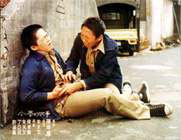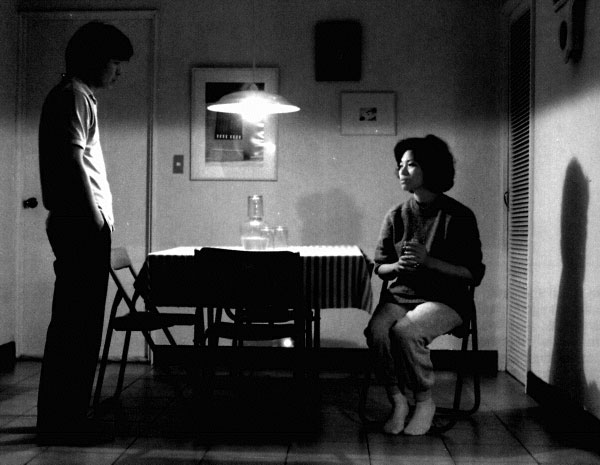Cinema of Taiwan
The history of Chinese-language cinema has three separate threads of development: Cinema of Hong Kong, Cinema of China and Cinema of Taiwan. Taiwanese cinema grew up outside of the Hong Kong mainstream and the censorship of the People’s Republic of China.
Taiwanese cinema is deeply rooted in the island’s unique and rapidly changing history. Since its introduction to Taiwan in 1901, cinema has developed in Taiwan through several distinct stages.
Early cinema, 1900 – 1970s
Cinema arrived on the island of Taiwan in 1901. For the first 20 years, only the Japanese made documentaries and feature films. In order to keep the colonial structure intact, the Japanese excluded any Taiwanese actors until 1922 in a film called The Eyes of Buddha. The first truly Taiwanese film, meaning local talent and financing, came in 1925 with Whose Fault Is It? Gradually, a vertically integrated industry formed using Taiwanese talent and capital. This was, of course, tightly controlled by the Japanese, and the local films drew on Japanese conventions in the silent era. For example, the benshi, the narrator that sat next to the screen and supplemented the music and images in Japan was adopted and re-termed as benzi by the Taiwanese. They also used another Japanese convention called the rengasi (rensageki in Japanese), which was a curious hybrid of film and theater that used cinema to stage spectacle for the stage. The industry was interrupted in 1937 by the Sino-Japanese War, and virtually nothing was produced until after the Nationalist government took over the island in 1945.
With the end of the civil war in 1949, Shanghai filmmakers sympathetic to the Nationalists accompanied Chiang Kai-shek to Taiwan, and after the economy stabilized, these exiled filmmakers formed the heart of a new film community in Taiwan in the 1950s. Like other industries in the island, the film industry slowly developed in this period with the help of government subsidy. Mandarin and low-budget dialect films constituted the core of the nation’s film production. A bilingual film system only lasted for a short period. Dialect film production in Taiwanese soon declined for two reasons: 1) the government attempted to unify the country by declaring Mandarin Chinese the official language of public discourse, and 2) the low-budget fare of dialect films were outclassed by the government-subsidized Mandarin films.
By the 1960s, modernization rapidly expanded in the island. Economic development, civil education, and industrialization were held as the major projects by the government. In 1963, the government’s Central Motion Picture Corporation (CMPC) introduced “Health Realism” melodrama. This genre featured positive attitudes towards traditional moral values that reflected the attempt to reconcile the inherited ambivalence between the socioeconomic restructuring and moral/ethical values in traditional agricultural society. Their most potent competition were period sword films. In addition to these two strains, there were also romantic melodramas, usually based on the stories of woman author named Qong Yao. In the 1970s, health-realism was replaced by Qong Yao’s romantic melodrama. The latent anxiety of reconciling modernity and tradition vis a vis rapid socioeconomic change was still present in these films. It was manifested primarily through individual (class, gender) conflict with traditional ethical/moral values in many melodramatic films.
In the late 1970s, a sub-genre called “social realism” emerged, featuring sex, violence, and gang subculture. The display and representation of explicit violence, mystified masculinity and misogynous depiction of female sexuality appeared to respond to the long history of the government’s repression of sexuality and physicality in cinema through censorship. This low-budget fare soon declined after insatiable repetitions of similar narrative structures and of banal spectacles of sex and violence.
New Wave Cinema, 1982 – 1990

These financial pressures forced the industry to seek new ways of competing with the Hong Kong films. The first initiatives were taken by CMPC with the support of fresh, young directors. Under the supervision of the CMPC, a portmanteau film called In Our Time, composed of four distinct episodes by four new directors, was produced in 1982. It represented the first break with the old, escapist filmmaking. The film is a review of social change in Taiwan over three decades. Unlike standard Taiwanese fare, this film cast non- or semi-professional actors instead of famous stars and did not follow a traditional narrative structure or fit into any generic category. Because of these innovations, In Our Time is generally accepted as the starting point of the New Cinema Movement.
Yet the New Cinema did not materialize until other innovative films appeared and achieved broader recognition. In 1983, Growing Up (directed by Chen Kunhou and produced by Hou, see photograph to the left) and another portmanteau film, The Sandwich Man (directed by three young filmmakers, including Hou Hsiao-hsien, the director of City of Sadness) attracted a great deal of attention. In particular, The Sandwich Man, composed of three distinct episodes, can be regarded as the hallmark of the movement. The film portrays Taiwan during the cold war period when the country developed its economy with the assistance of aid from the United States.
With a special emphasis on the workers and their misery and their ignorance which resulted from their poverty and deprivation, each episode is different in style. The Sandwich Man was much discussed in the press at the time and was regarded as a significant break with domestic and Hong Kong mainstream cinema. Because of the commercial success and critical acclaim of Growing Up and The Sandwich Man, these new directors were provided with more opportunities to experiment with innovative filmmaking ideas. From this point on, the New Cinema began to develop more fully.

From 1983 through 1989, approximately ten filmmakers participated in this movement, each has respectively developed his (they are exclusively male) own style and has made his own contribution to the New Cinema. For example, Hou Hsiao-hsien’s strongly autobiographical films — The Boys From Fengkuei(1983), A Time to Live and A Time to Die (1985), Son’s Big Doll, the first episode in The Sandwich Man (1983), A Summer at Grandpa’s (1984), and Dust in the Wind (1986) — reveal a realism that is startling in its authentic and artistic portrayal of rural life in Taiwan. Because of his unique observational, documentary- like style — i.e., the use of deep focus and long takes, non-linear narrative, discontinuity editing, and portrayal of the daily lives of the Taiwanese — Hou Hsiao-hsien has been acclaimed as the most representative auteur of Taiwan’s national cinema by local film critics. (For discussions on Hou, please see our Bibliography under the subject term Hou) His personal victories on the international film festival circuit, including his receipt of the Golden Lion at Venice for City of Sadness, have represented a triumph and vindication of the Taiwanese New Cinema.
Another leading auteur of the New Cinema is Yang Dechang (Edward Yang). Regarded as Hou’s cinematic equal, Yang is remarkably different from Hou in terms of style and subject matter. Unlike Hou, who always focuses on males, childhood, adolescence, and rural life, Yang is concerned with women, the newly emerging middle class, and urban society. In his three features (That Day, on the Beach, Taipei Story [which starred Hou, see photograph above] and The Terrorizer), Yang consistently addresses the social and personal problems that confront the urban, intellectual, and cultural elite in the increasingly industrialized, Japan-influenced, and Westernized Taipei.
Because of Yang’s urban emphasis, the cinematic language he employs is similar to the modernist aesthetic associated with European art cinema. In discussing his work, critics often invoke Antonioni, an observation Yang detests. Detached camera movement, long takes, non- linear narrative, multiple diegeses, location shots, and discontinuity editing, are the hallmarks of Yang’s techniques. His skillful utilization of modernist tropes, sharp observations on Taiwan’s high-tech, capitalistic, alienated urban life, and retrospective looks at the island’s tremendous social changes are also important elements in his films.
Form and Substance
New Cinema directors, all of whom grew up in the post-WWII era during Taiwan’s socioeconomic restructuring from an agricultural to an industrialized and capitalist society, examine the various problems that Taiwanese people have to cope with in an increasingly modernized society. In order to create a cinema that entails a more realistic relationship with history and memory, most new films are shot on location. Under a similar notion, minor or non-professional actors are cast to evoke a more “true- to-life” atmosphere.
Clearly influenced by Italian neorealism, the new directors are committed to a quasi-documentary style in their filmmaking. They draw deeply on their life experiences to construct their narratives and in their deployment of mise-en-scene. Their narratives often pit the working or peasant classes against a background of deprivation and misery. Almost every new film tries to reconstruct history to some extent. The look at the rural, agricultural past is nostalgic; the attitude toward the urban, industrial present is bitter. As a result, a set of thematic binary pairs can often be found in these films: rural (backward, peaceful) vs. urban (advanced, turbulent); peasant/working class (innocent, benevolent) vs. middle class (sophisticated, manipulative); past (good) vs. present (bad).
In addition to these themes, an unprecedented concern with the daily lives of local people has been shown by the new directors, particularly with respect to native cultures and languages. In addition to Mandarin, the official language in Taiwan, other major dialects are included, such as Taiwanese Amoy (the major Jufian dialect spoken in Taiwan) and Hakka.
Because of the power struggle between the Chinese Communists and Nationalists over the four decades since WWII, the Nationalist Party has insisted that the government in Taiwan represents the true China and, therefore, the real Chinese culture. Moreover, when the Nationalist army first came to Taiwan in 1945, a bloody conflict occurred between the Taiwanese and the mainlanders, climaxing with the 2.28 Incident. As a result, the government privileges the so-called “Mid-Land” culture, a culture developed by the Yellow River Valley inhabitants in China since 2000BC, as the single culture that everyone in Taiwan must accept as their own; the native languages (ie., Taiwanese Amoy and Hakka) and cultures were officially suppressed.
The New Cinema directors have responded to a recent increase in the public consciousness of the movement to return to the native and regional cultures. They have used actors who speak Taiwanese Amoy dialect to portray real-life ordinary people. Hou Hsiao-hsien may be the filmmaker who has dealt most carefully with the trilingual phenomenon (Mandarin, Taiwanese Amoy and Hakka) in Taiwan. His Summer at Grandpa’s, A Time to Live and A Time to Die, and City of Sadness present multiple dialects to oppose the government’s forced monolingualism.
Another thematic re-orientation by the Taiwan New Cinema is the direct reference to political and social taboos. Behind this phenomenon we may find the lifting of martial law in 1987 and the political, social, and diplomatic reform policies that followed, as well as growing demands for more radical reforms from civilians. Three films made in 1989 — City of Sadness, Banana Paradise, and Gangs of Three — touched on political controversies that were considered highly sensitive and forbidden in public discourse before 1987.
In addition to the realist approach to subject matter, the New Cinema stands out for an additional reason: the continuing effort to explore the medium’s specificity. (For original discussions on this topic, please see Bibliography: references listed in subject terms under Taiwanese New Cinema) Rather than conform to the myth that filmmaking should follow generic conventions to fulfill audience expectations, the new directors negotiated commercialism and art. They attempted to make films that sometimes agitated the audience, sometimes forced thoughtful reflection.
Clearly influenced by the Western modernist movement, the narrative structure in these films is more fragmented than linear, the editing is more obtrusive than continuous, and sentimental expression has been suspended to block out emotional identification. Off-screen sound has been used frequently to convey a sense of alienation (especially in the films of Hou and Yang); the frequent use of close-ups is replaced by long takes and long shots that make for a more distanced perspective. This is particularly clear in the manner in which scenes of action are constructed, as we argue in our analysis of the representation of violence.
However, differences exist among individual directors, even though most of them share a common purpose — exploring the full potential of filmmaking. Wan Ren, for example, despite his quite modernist approach, still emphasizes melodrama in his films. His first work, the episode in The Sandwich Man called The Taste of Apples, successfully conveys the bitter taste of the postcolonial mentality, not because of detached camerawork and fragmented narrative, but because of his use of conventional ways of creating dramatic ironies and comic effects. Another filmmaker, Zhang Yi, concentrates on depicting female psychology in a classical realist tradition. Jade Love is one good example which shows his use of a classical realist narrative to articulate his criticism of feudal patriarchy.
Rejecting the stereotypical concept of filmmaking dearly held by the veteran directors as mere commodity and political propaganda, the New Cinema strives for medium specificity in documenting the social and cultural realities of Taiwan. Yet this bourgeois-humanistic ideology in re-directing the look of Taiwanese cinema does generate debates when a new critical regime came into power with the rise and success of the new films. The critical regime of critics trained in Western academic contexts contested interpretive authority of veteran critics and their institutional territory, the newspaper column. Their attention to and support of the new filmmakers involved less of an ideological struggle (i.e., Westernized aesthetic taste) than a larger question of survival and the power over discourse. As a result, it is not surprising to see that the attack on the new films came from the veteran critics. Based upon the domestic commercial disasters of the most celebrated filmmakers like Hou Hsiao-hsien and Edward Yang, who were criticized for their idiosyncratic and elitist filmic taste, critics dismissed them as hardly relevant to the majority of working class consumers.
Although the veteran critics’ remarks can be easily dismissed for being too simplistic and insensitive to artistic expression, it is exactly their take on the distinction between high art and low culture that provoked an interesting reconsideration of the New Cinema. As Taiwan approaches the 21st century, the New Cinema has almost become an obsolete term in discussing film in Taiwan. Given this fact the New Cinema does not renovate the industry nor does it build up a solid reservoir for domestic filmmaking to compete with Hong Kong product. Taiwan’s film market continues to be dominated by Hong Kong entertainment films. Many filmmakers who participated in the New Cinema have either ceased making films altogether or have been recruited into television production. Hou Hsiao-hsien and Edward Yang, on the other hand, have become the most internationally celebrated Taiwanese filmmakers, as evidenced by Hou’s coups at Venice for City of Sadness. and The Puppetmaster.
The question of how and why New Cinema was eventually rejected by the audience requires further investigation. The more productive and fruitful approach to examine this question will rely upon reconceptualizing the concept of national cinema in Taiwan. The question of art cinema and popular cinema in relation to the industrial and commodity system in Taiwan seems to be the main issue underlying the many objections raised against the new directors, a consideration that has been ignored for too long and too easily. These are, of course, questions beyond the scope of the present project. By raising these issues, however, we hope to at least provide a provocative backdrop for our analysis of City of Sadness.

– Source : cinemaspace.berkeley.edu





